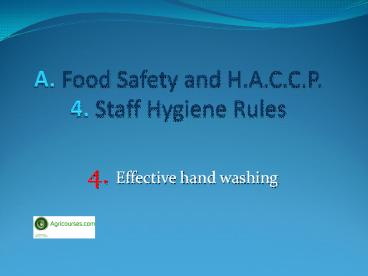Lecture 4: Effective hand washing PowerPoint PPT Presentation
Title: Lecture 4: Effective hand washing
1
A. Food Safety and H.A.C.C.P.4. Staff Hygiene
Rules
4. Effective hand washing
2
What is effective hand washing?(part I)
- the act of cleansing hands by applying soap and
water, rubbing them together vigorously, rinsing
them with clean water and thoroughly drying them.
- this process gets rid of dirt and germs
3
What is effective hand washing?(part II)
- every hand washing stage is important and
effectively contributes to soil removal and
reduction of microorganisms that can cause
illness
4
Why is hand washing important?(part I)
- It reduces the spread of pathogenic
microorganisms that are transmitted through food - the hands of food employees can be colonized with
microorganisms such as Staphylococcus aureus or
Escherichia coli or Salmonella
5
Why is hand washing important?(part II)
- these and other pathogenic microorganisms can get
on the hands from a number of sources and then
move from hands to food during preparation and
service.
6
When should food employees wash their hands?
(part I)
- when entering a food preparation area
- before putting on clean, single-use gloves for
working with food and between glove changes - before engaging in food preparation
- before handling clean equipment and serving
utensils - when changing tasks and switching between
handling raw foods and working with RTE foods
7
When should food employees wash their hands?
(part II)
- after handling soiled dishes, equipment, or
utensils - after touching bare human body parts (for
example, parts other than clean hands and clean,
exposed portions of arms) - after using the toilet
- after coughing, sneezing, blowing the nose, using
tobacco, eating, or drinking.
8
Proper hand washing procedure
Wet your hands
Rub your hands from fingertips to elbows for 20
sec
Apply soap
Use a brush to scrub your nails
Rinse both sides of hands with water
Dry your hands with a clean paper towel
9
Suitable equipment for hand washing
disinfectant
paper towels
soap
hand dryer
Push button valve for hot and cold water using
your foot
dustbin with foot pedal
10
Alcohol-based preparations
- Soap and water should be used wherever possible
when washing hands - Skin disinfectants formulated for use without
water (e.g. 7080 alcohol-based solutions) can
be used to decontaminate hands when hand washing
facilities are not available (they do not replace
the importance of hand washing with soap and
water) - Alcohol preparations are not useful if hands are
visibly soiled with body fluids, feces or vomit
11
How important is the temperature of water used
for hand washing?
- Warm water is generally more comfortable than
cold water and encourages hand washing for the
recommended duration - The water temperature used in hand washing can
also affect the solubility or emulsification of
some soils - Warm water is more effective than cold water in
removing fatty soils
12
How important is properly drying your hands after
hand washing?
- It is a vital part of the hand washing process
because thorough hand drying can provide an added
reduction of microorganisms on the hands. - Effective hand drying includes drying your hands
with an air dryer and using a single-use towel or
a clean, unused towel.
13
Frequent hand washing is necessary
14
Summary of 4th Lecture
- What effective hand washing is
- When food employees should wash their hands

